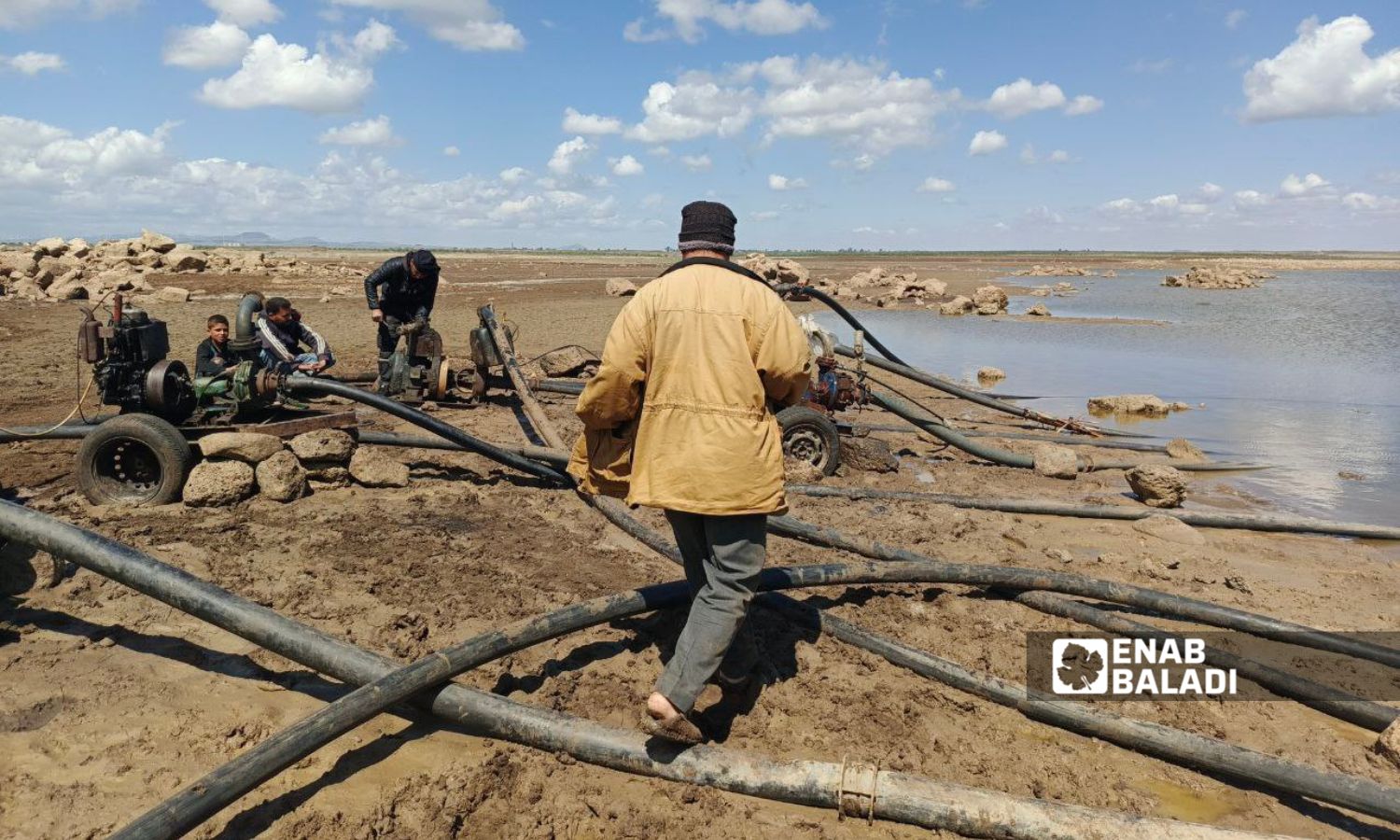



Daraa – Mahjoub al-Hashish
Most farmers in Daraa province, southern Syria, have been unable to irrigate their crops, such as wheat, barley, peas, and fava beans, due to the shortage of rainfall, which has affected the quality of these crops.
It is expected that this will have a negative impact on productivity, while costs are rising, as farmers have relied on diesel engines to secure irrigation water, while others have sold their harvest for animal feed.
Farmer Ahmad al-Hariri, a resident of the town of Mlihah al-Atash in the eastern countryside of Daraa, was unable to irrigate his entire wheat crop this season due to dry soil and lack of moisture during December 2024 and January, due to the absence of rainfall.
Al-Hariri, who owns 150 dunams of wheat, stated that he could only irrigate four to five dunams a day, while he had irrigated more than 25 dunams a day in 2024, as rainfall had helped nourish the crops.
This situation has incurred him additional costs in diesel engine operation, as he requires 160 liters of diesel per day, with the price of one liter reaching 10,000 Syrian pounds.
The farmer called for the reinstatement of support for farmers in the form of diesel fuel, which the Syrian government has canceled since the downfall of Assad’s regime.
Agricultural engineer Ahmad Kiwan stated to Enab Baladi that the wheat crop has entered the tasseling stage, where the nutrition is meant to form the grain, while the height of the wheat stalk in most fields is still below 20 centimeters, whereas it should exceed 50 centimeters at this time of year.
He added that the wheat has not benefited from rainfall because of its scarcity, which contains nitrogen and organic matter, making irrigation water insufficient regardless of the amounts used, according to the engineer.
The engineer estimated the success rate of this year’s wheat crop at 5%, mostly from irrigated lands, which could produce wheat and straw.
However, the rain-fed crops of wheat and barley are out of production, and most have become suitable only for grazing, according to Kiwan.
According to the latest statistics from the Daraa Agriculture Directorate, the area planted with irrigated wheat this season reached 9,204 hectares out of a planned 10,000 hectares, achieving a 92% implementation rate, indicating that the crop’s condition ranges from good to average.
The planned area for rain-fed wheat is 86,317 hectares, of which 41,299 hectares have been planted, achieving a 47.8% implementation rate.
Director of Agriculture, Ahed al-Zoubi, stated that the absence and delay of rainfall has contributed to the low implementation rate of rain-fed wheat cultivation and the early exit of some planted areas, and that the condition of sprouting for 2,000 hectares is good, for 5,200 hectares is medium, and the rest is weak.
Khaled al-Hashish sold 100 dunams of his wheat crop as pasture for livestock after being unable to complete the irrigation of the crop.
Al-Hashish owns 150 dunams of wheat, managing to irrigate only 50 dunams, while it has become ineffective to irrigate the rest of the crop.
Al-Hashish told Enab Baladi that the land consumed large amounts of water, which previous years’ rainfall would compensate. He added that the wheat crop is strategic for him, as he plants it every year, but he did not expect to be unable to complete its irrigation.
The nearby Zeyzoun lake has flowed again since last February, but extensive water extraction for irrigation and operating wells quickly led to its depletion once more.
Moreover, the continuous extraction of irrigation water during the winter has affected the hot springs of Ain al-Sakhina, Ain al-Abd, and the al-Muzayrib lake, which have not returned to flow this year.
Not only has the wheat and barley season been affected, as pea and fava bean crops also suffered damage that impacted their production.
Mahmoud Kiwan, a farmer with 20 dunams planted with peas, stated that he could not irrigate them, forcing him to sell them as pasture for sheep.
Kiwan noted that peas relied on rainfall in previous years and do not consume large quantities of irrigation water.
Meanwhile, Yousuf al-Salem intended to plant 15 dunams of chickpeas, but the lack of rainfall during winter led him to cancel the project due to insufficient soil moisture and anticipate rising straw prices (comprising wheat, barley, fava beans, and peas).
In recent years, drought has affected important water sources in Daraa, leading to the depletion of thousands of random wells, which has deepened the effects of the current drought wave and weakened agriculture, the most important source of livelihood in Daraa, “the basket of Syrian vegetables,” making matters more difficult as the government has failed to find alternatives.
Among the crops most affected by the drought in Daraa is olive, although its trees are more resistant to drought than others, they can only be watered twice in summer, provided the soil is plowed continuously to maintain moisture, according to an investigation by Enab Baladi/Syria Indicator.
if you think the article contain wrong information or you have additional details Send Correction